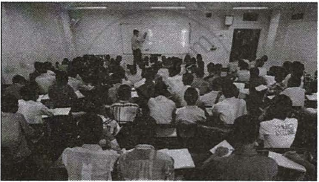Advertisements
Advertisements
Question
If three times the larger of two numbers is divided by the smaller, we get 4 as the quotient and 8 as the remainder. If five times the smaller is divided by the larger, we get 3 as the quotient and 5 as the remainder. Find the numbers.
Solution
We know:
Dividend = Divisor × Quotient + Remainder
Let the larger number be x and the smaller be y.
Then, we have:
3x = y × 4 + 8 or 3x – 4y = 8 ……….(i)
5y = x × 3 + 5 or –3x +5y = 5 ………(ii)
On adding (i) and (ii), we get:
y = (8 + 5) = 13
On substituting y = 13 in (i) we get
3x - 4 × 13 = 8
⇒ 3x = (8 + 52) = 60
⇒ x = 20
Hence, the larger number is 20 and the smaller number is 13.
APPEARS IN
RELATED QUESTIONS
For what value of α, the system of equations
αx + 3y = α - 3
12x + αy = α
will have no solution?
Obtain the condition for the following system of linear equations to have a unique solution
ax + by = c
lx + my = n
Find the values of p and q for which the following system of linear equations has infinite a number of solutions:
2x - 3y = 9
(p + q)x + (2p - q)y = 3(p + q + 1)
Solve for x and y:
0.3x + 0.5y = 0.5, 0.5x + 0.7y = 0.74
Find the value of k for which the system of equations
8x + 5y = 9, kx + 10y = 15
has a non-zero solution.
If 45 is subtracted from twice the greater of two numbers, it results in the other number. If 21 is subtracted from twice the smaller number, it results in the greater number. Find the numbers
The sum of the digits of a two-digit number is 15. The number obtained by interchanging the digits exceeds the given number by 9. Find the number.
The sum of the numerator and denominator of a fraction is 8. If 3 is added to both of the numerator and the denominator, the fraction becomes `3/4`. Find the fraction.
Places A and B are 160 km apart on a highway. A car starts from A and another car starts from B simultaneously. If they travel in the same direction, they meet in 8 hours. But, if they travel towards each other, they meet in 2 hours. Find the speed of each car.
Read the following passage:
|
A coaching institute of Mathematics conducts classes in two batches I and II and fees for rich and poor children are different. In batch I, there are 20 poor and 5 rich children, whereas in batch II, there are 5 poor and 25 rich children. The total monthly collection of fees from batch I is ₹9,000 and from batch II is ₹26,000. Assume that each poor child pays ₹x per month and each rich child pays ₹y per month.
|
Based on the above information, answer the following questions:
- Represent the information given above in terms of x and y.
- Find the monthly fee paid by a poor child.
OR
Find the difference in the monthly fee paid by a poor child and a rich child. - If there are 10 poor and 20 rich children in batch II, what is the total monthly collection of fees from batch II?

